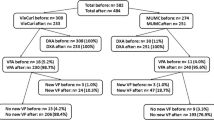Abstract
The aim of this study was to evaluate the prevalence of spine–femur discordance, and to compare the effectiveness of femoral neck (FN) and lumbar spine (LS) bone mineral density (BMD) for estimation of the risk of vertebral fractures. Women who were evaluated with dual energy X-ray absorptiometry between January 2001 and December 2005 were enrolled in this study. Vertebral fracture risk was calculated using initial FN and LS BMD. The follow-up vertebral X-rays from all subjects were reviewed, and the calculated estimated risk using the Fracture Risk Assessment Tool (FRAX®) was compared with the actual prevalence of vertebral fractures during the follow-up period. Among a total of 443 women with a mean age of 58.5 years, 130 women (29.3 %) demonstrated femur–spine discordance (i.e., a difference between FN and LS BMD of >1 SD). Most subjects having discordance showed lower LS BMD (73.1 %) compared to FN BMD. During the mean 7-year follow-up period, 12 (2.7 %) vertebral fractures occurred. In cases with high estimated fracture risk (>20 % for estimated fracture risk), using LS BMD significantly reflected the actual vertebral fracture in total subjects [odds ratio (OR) 19.29, 95 % confidence interval (CI) 4.21–88.46], in subjects with spine–femur discordance (OR 16.00, 95 % CI 1.91–134.16), and in subjects with spine–femur discordance having lower LS BMD (OR 20.67, 95 % CI 1.63–262.71). In comparison, the estimated risk using FN BMD did not reflect the actual occurrence of vertebral fractures. In conclusion, a significant number of Korean subjects exhibited spine–femur discordance, and LS BMD might be more appropriate for estimation of vertebral fracture risk.
Similar content being viewed by others
References
Kanis JA, Oden A, Johnell O, Jonsson B, de Laet C, Dawson A (2001) The burden of osteoporotic fractures: a method for setting intervention thresholds. Osteoporos Int 12:417–427
Johnell O, Kanis JA (2006) An estimate of the worldwide prevalence and disability associated with osteoporotic fractures. Osteoporos Int 17:1726–1733
Melton LJ 3rd (2003) Adverse outcomes of osteoporotic fractures in the general population. J Bone Miner Res 18:1139–1141
Lee YK, Jang S, Lee HJ, Park C, Ha YC, Kim DY (2012) Mortality after vertebral fracture in Korea: analysis of the National Claim Registry. Osteoporos Int 23:1859–1865
Park C, Ha YC, Jang S, Yoon HK, Lee YK (2011) The incidence and residual lifetime risk of osteoporosis-related fractures in Korea. J Bone Miner Metab 29:744–751
Papaioannou A, Watts NB, Kendler DL, Yuen CK, Adachi JD, Ferko N (2002) Diagnosis and management of vertebral fractures in elderly adults. Am J Med 113:220–228
Kanis JA, Oden A, Johnell O, Johansson H, De Laet C et al (2007) The use of clinical risk factors enhances the performance of BMD in the prediction of hip and osteoporotic fractures in men and women. Osteoporos Int 18:1033–1046
Kanis JA, Borgstrom F, De Laet C, Johansson H, Johnell O, Jonsson B, Oden A, Zethraeus N, Pfleger B, Khaltaev N (2005) Assessment of fracture risk. Osteoporos Int 16:581–589
Adachi JD, Loannidis G, Berger C, Joseph L, Papaioannou A, Pickard L, Papadimitropoulos EA, Hopman W, Poliquin S, Prior JC, Hanley DA, Olszynski WP, Anastassiades T, Brown JP, Murray T, Jackson SA, Tenenhouse A (2001) The influence of osteoporotic fractures on health-related quality of life in community-dwelling men and women across Canada. Osteoporos Int 12:903–908
Leslie WD, Lix LM (2011) Absolute fracture risk assessment using lumbar spine and femoral neck bone density measurements: derivation and validation of a hybrid system. J Bone Miner Res 26:460–467
Leslie WD, Kovacs CS, Olszynski WP, Towheed T, Kaiser SM, Prior JC, Josse RG, Jamal SA, Kreiger N, Goltzman D (2011) Spine–hip T score difference predicts major osteoporotic fracture risk independent of FRAX((R)): a population-based report from CAMOS. J Clin Densitom 14:286–293
Lau EM, Lee JK, Suriwongpaisal P, Saw SM, De Das S, Khir A, Sambrook P (2001) The incidence of hip fracture in four Asian countries: the Asian Osteoporosis Study (AOS). Osteoporos Int 12:239–243
Chang KP, Center JR, Nguyen TV, Eisman JA (2004) Incidence of hip and other osteoporotic fractures in elderly men and women: Dubbo Osteoporosis Epidemiology Study. J Bone Miner Res 19:532–536
Kim KM, Brown JK, Kim KJ, Choi HS, Kim HN, Rhee Y, Lim SK (2011) Differences in femoral neck geometry associated with age and ethnicity. Osteoporos Int 22:2165–2174
Genant HK, Wu CY, van Kuijk C, Nevitt MC (1993) Vertebral fracture assessment using a semiquantitative technique. J Bone Miner Res 8:1137–1148
Cauley JA, Thompson DE, Ensrud KC, Scott JC, Black D (2000) Risk of mortality following clinical fractures. Osteoporos Int 11:556–561
Leslie WD, Lix LM, Johansson H, Oden A, McCloskey E, Kanis JA (2012) Does osteoporosis therapy invalidate FRAX for fracture prediction? J Bone Miner Res 27:1243−1251
Acknowledgments
This work was supported by a National Research Foundation of Korea (NRF) grant funded by the Korean government (MEST, No. 20110001024). The funding agency had no role in study design, data collection and analysis, decision to publish, or preparation of the manuscript.
Conflict of interest
The authors disclose that they have no conflicting interests in this work.
Author information
Authors and Affiliations
Corresponding author
About this article
Cite this article
Seok, H., Kim, K.J., Kim, K.M. et al. High prevalence of spine–femur bone mineral density discordance and comparison of vertebral fracture risk assessment using femoral neck and lumbar spine bone density in Korean patients. J Bone Miner Metab 32, 405–410 (2014). https://doi.org/10.1007/s00774-013-0512-3
Received:
Accepted:
Published:
Issue Date:
DOI: https://doi.org/10.1007/s00774-013-0512-3




